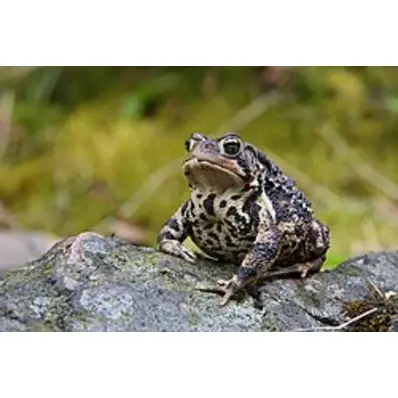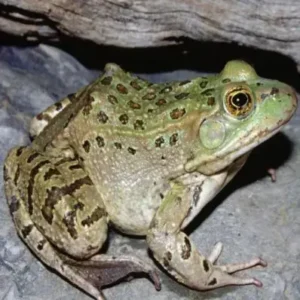History/Origin
The American toad stands as a native amphibian species with a compelling history deeply rooted in North America. This resilient creature boasts a remarkable evolutionary journey spanning millions of years.
Throughout this extensive timeline, these north American toads have demonstrated an exceptional ability to adapt to a wide array of environments, ranging from dense forests to suburban gardens. Their rich history reflects the American toad’s integral role in the United States’s ecosystems and highlights its significance as a fascinating component of the continent’s natural heritage.
Personality
American toads are generally nocturnal and solitary creatures. Known for their gentle demeanor, they spend their days hiding and become active during the night. Their primary focus is on feeding and finding mates during the breeding season.
They have a remarkable ability to withstand cold weather. They possess distinctive features such as parotoid glands, which secrete toxins as a defense mechanism, and cranial crests, which add to their unique appearance.
Physical Appearance
- Size: American toads typically range from 2 to 4½ inches in length, with females being slightly larger than males.
- Color: Their skin exhibits various shades of brown, olive-green, and reddish-brown, often featuring distinctive dark spots. This coloration serves as a camouflage, helping them blend into their natural surroundings.
- Distinctive Features: They have short legs, stout bodies, and thick skins adorned with noticeable warts, contributing to their rugged appearance.
Gender Differences
Male and female American toads exhibit distinct characteristics, with size and skin texture being prominent indicators. Typically, male toads are smaller in size compared to their female counterparts. In addition to the size contrast, males often feature rougher skin texture.
A notable gender-specific transformation occurs during the breeding season. Male American toads undergo a distinctive change as they develop a dark throat. This darkening serves a crucial purpose, acting as an amplification mechanism for their mating calls.
This adaptation is essential for effectively attracting potential mates in the breeding chorus. Therefore, these gender differences in size, skin texture, and the development of a dark throat play pivotal roles in the reproductive behaviors of American toads.
American toad undergoes a captivating life cycle, starting from toad tadpoles to baby American toads that transform into terrestrial adults.
Feed/Nutrition
American toad diet is exclusively carnivorous, relying on various living organisms.
- Insect Predation: A significant portion of their diet consists of insects, including beetles, ants, and crickets. This dietary preference aligns with their ecological role as efficient insect hunters.
- Consumption of Spiders: American toads also incorporate spiders into their diet, showcasing a diverse palate that contributes to their overall nutritional intake.
- Small Invertebrates: Beyond eating insects, American toads eat small invertebrates, such as worms and larvae. This wide variety of diets ensures a well-rounded nutritional profile.
The diverse array of prey in their diet provides essential nutrients, including proteins and vitamins. This balanced nutritional intake supports the overall health and vitality of American toads, enabling them to thrive in their respective ecosystems.
Feeding Practices
Feeding pet American toads involves offering a diet of live insects, such as crickets and mealworms, dusted with calcium powder for nutritional balance. Provide an appropriately sized portion, ensuring it aligns with the toad’s size and age.
Feed every 1-2 days, adjusting frequency based on individual needs. Fresh water should be available at all times. Monitoring their eating habits and adjusting their diet accordingly ensures optimal health for these captivating amphibian companions.
Health
American toads may face various health issues, including:
- Red-leg Syndrome:
Red-leg syndrome is a prevalent health concern among American toads. This bacterial infection, often caused by Aeromonas or Citrobacter, manifests as red discoloration on the abdomen and limbs. It may be accompanied by lethargy and loss of appetite.
- Parasitic Infections:
American toads can be susceptible to parasitic infestations, particularly by nematodes and protozoans. Regular fecal examinations and appropriate veterinary treatment are essential for managing and preventing these infections.
- Skin Lesions:
Skin lesions, resulting from injuries, infections, or environmental stressors, are common. Maintaining a clean and suitable habitat minimizes the risk of skin issues.
- Metabolic Bone Disease (MBD):
Inadequate calcium intake may lead to metabolic bone disease, affecting bone structure. Supplementing their diet with calcium and ensuring proper UVB exposure aids in preventing MBD.
- Obesity:
Overfeeding and lack of physical activity can contribute to obesity in captive American toads. Monitoring food intake and providing opportunities for exercise are crucial for maintaining a healthy weight.
American Toad Care and Grooming
Creating an optimal living environment for American toads involves maintaining a consistently moist habitat, as they thrive in humid conditions. Ensure hiding spots, such as rocks or vegetation, to mimic their natural shelters.
Regular grooming encompasses keeping their habitat clean by removing waste and uneaten food promptly. Additionally, monitoring their health is crucial. Addressing any signs of illness promptly and providing a well-balanced diet are grooming practices essential for the well-being of these amphibians.
Rescue Groups
American toads are generally common and lack a specific conservation status. However, certain populations have declined, possibly due to pollution. Here are some rescue groups that actively work towards their conservation.
Species for Sale
American toads are divided into three species based on their geographic distribution and subtle morphological differences. These include:
- Eastern American Toad (Anaxyrus americanus americanus)
- Dwarf American Toad (Anaxyrus americanus charlesmithi)
- Hudson Bay Toad (Anaxyrus americanus copei)
Some established pet stores, both physical and online, may offer American toads for sale. Prices typically range from $10 to $30, depending on factors such as age, size, and coloration.
Interesting Facts
- Moonlit Serenades: American toads synchronize their mating calls with the lunar cycle, often increasing vocal activity during full moons.
- Secretive Tadpole Hatching: Female American toads can deposit eggs in shallow water, where tadpoles hatch and develop before dispersing into the surrounding environment.
- Toxic Secretions: The glands behind their eyes secrete toxic substances, serving as a deterrent to predators attempting to consume them.
Best For
While they can be kept as pets, it’s important to consider the specialized care they require, making them more suitable for experienced amphibian enthusiasts or educational programs.
Top Names
| Male American Toad Names | Female American Toad Names |
| Jumper | Lily |
| Spike | Bella |
| Croaker | Luna |
| Blaze | Tessa |
| Rocky | Ember |










